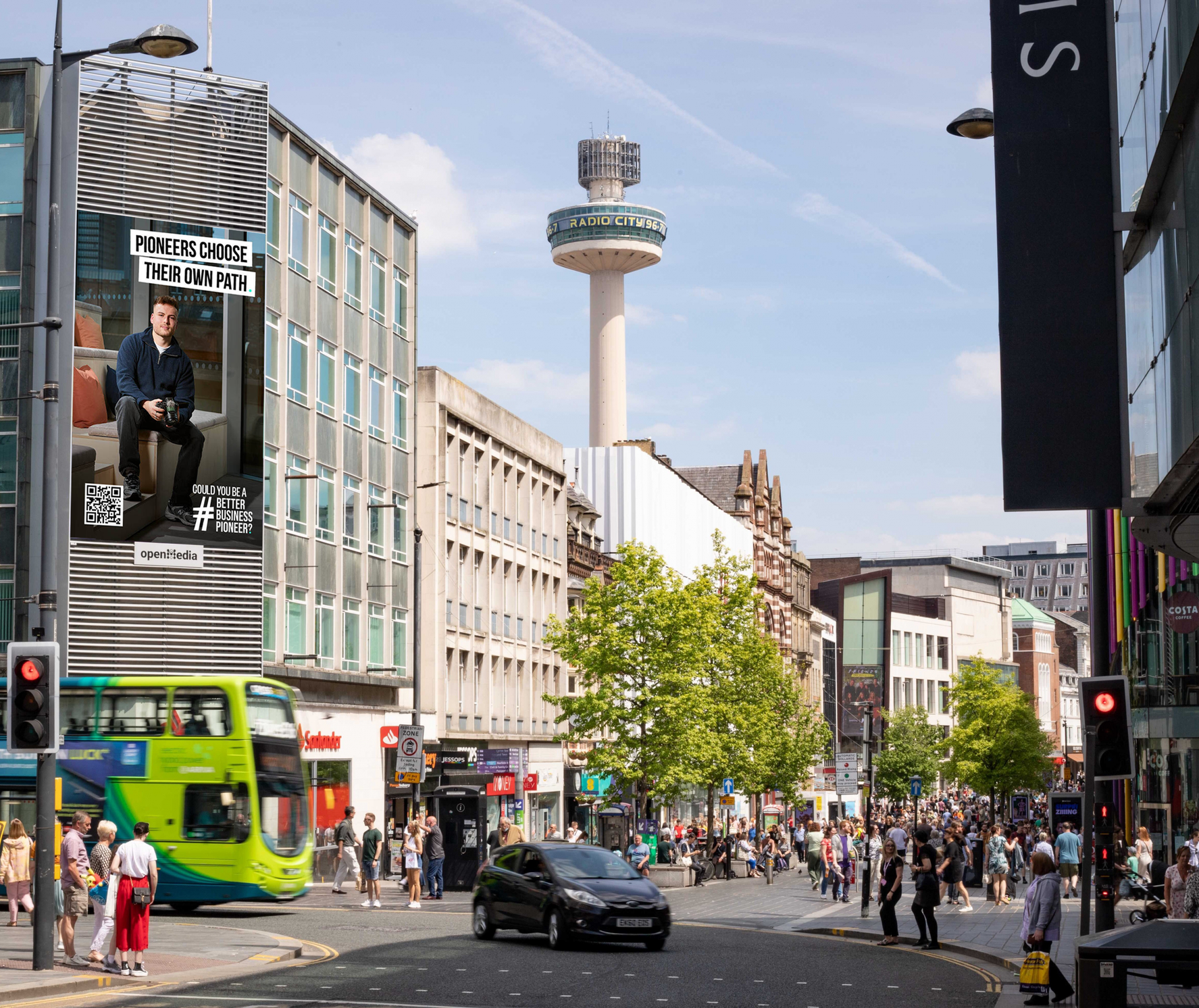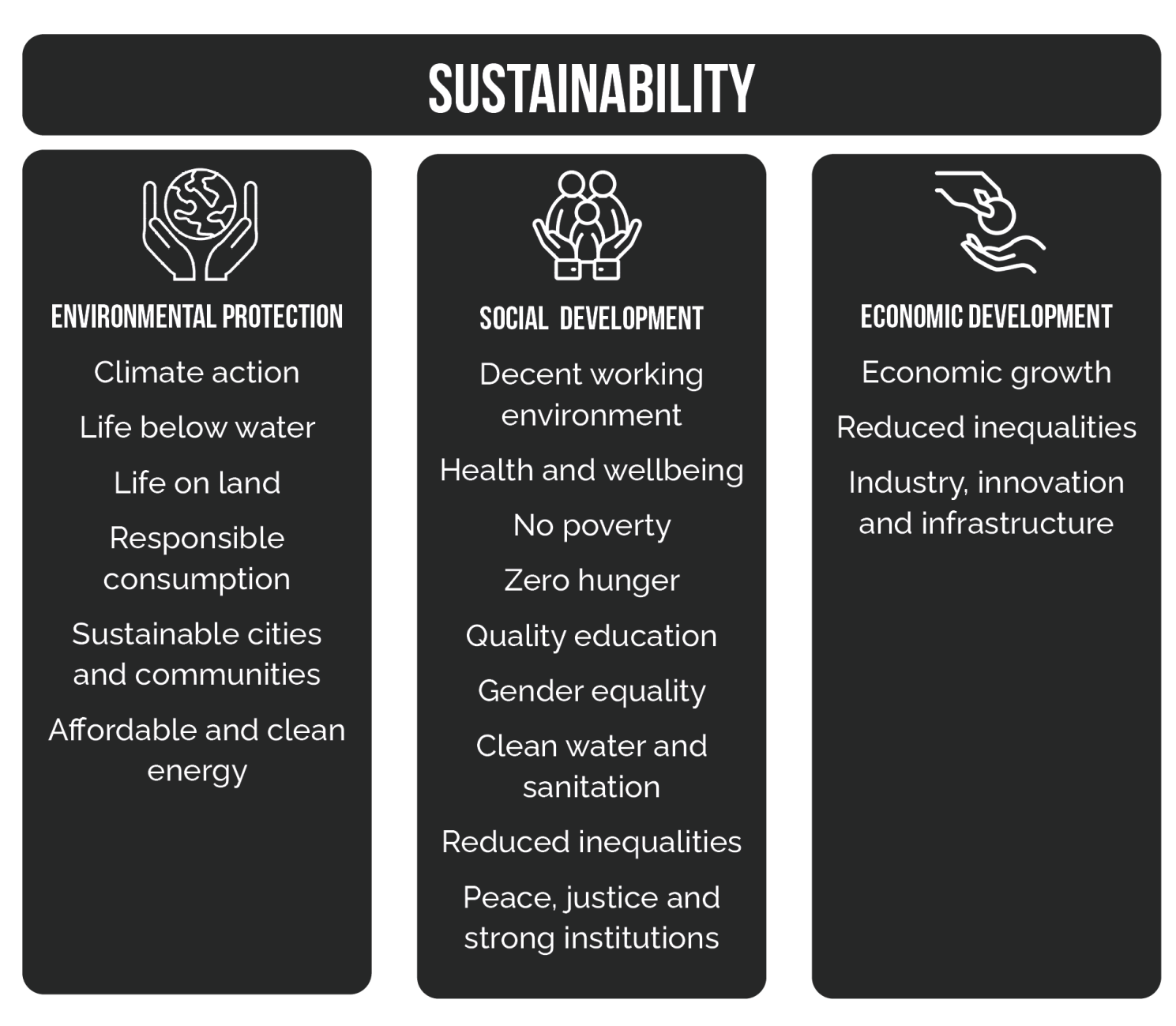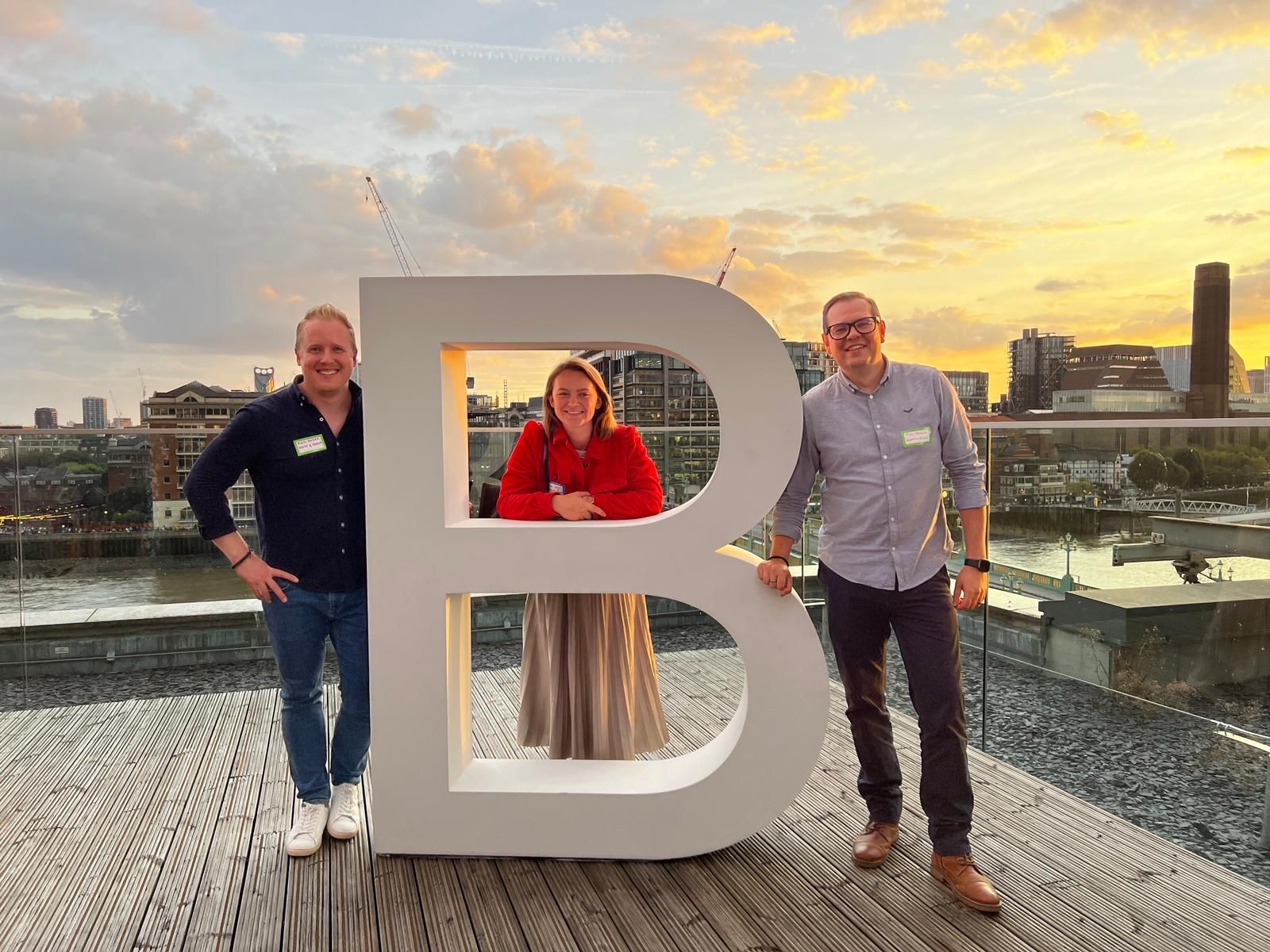The Ultimate Guide to Sustainable Marketing
Over the past three decades, marketing has rapidly evolved from a one-way broadcast to a conversation as the digital age has enabled a more intimate relationship between brands and their customers. At the same time, those customers have become increasingly wise to the tactics used to attract - or manipulate - them, with marketers coming under fire for deceptive claims, high-pressure sales, or disruptive tactics.
Consumer savviness has been simultaneously channelled into another arena. With the planet literally on fire, it's difficult to avoid the glaring realities of climate change. While we’re all guilty of overconsumption, the evidence suggests that consumers are starting to think more seriously about the impact their buying habits have on the planet. We are becoming more critical about what we buy and where it comes from, and we’ve started to expect more than just value and convenience.

Reducing our levels of consumption will not be a sacrifice but a bonus if we simply redefine the meaning of the word ‘success’. [1]
David Wann
So along comes sustainable marketing, with the aim of tackling both problems at once: the best friend to businesses in need and customers who want more. But what is it? How is it any different to conventional marketing? And why should you bother about it?
Well you'll just have to read on to find out. Go on, I dare you...
What is sustainability?
The term sustainability was first defined in the 1987 Brundtland Report as: 'progress that meets the needs of present generations without detrimentally affecting the needs of future generations.'
This basically means that to be sustainable you have to take a long-term outlook and assume resources are finite and must be protected. A sustainable society should be both socially responsible and concerned with environmental preservation, aiming to create a dynamic equilibrium between manmade and natural systems that allows both to exist without harming one another.
Sustainability is often broken down into three categories - sometimes referred to as 'people, planet, profit' - illustrated in the three pillars shown below. I've also broken down the
UN's Sustainable Development Goals into the three pillars to give an idea of what each involves.
As you can see, each of the three pillars of environmental protection, social development, and economic development bear an equal amount of the burden. And each sub-goal is interlinked: only by striving for them all equally, can we create a sustainable society. For example, without economic development, we will never reach zero hunger, meaning we can never tackle the issues of responsible consumption, and consequently, species protection (life on land/life below water). Again, without reducing global inequality, and therefore encouraging economic growth, we can never expect countries to have equal budgets to put towards clean energy or sustainable construction.
Sustainability and business:
Businesses have historically been the greatest contributors to climate change -
a 2017 report found that 71% of global emissions since 1988 can be traced to just 100 corporations. However, this also means they hold a key role in driving positive action.
Traditional business strategy focuses on maximising profit by reducing costs and mitigating risk. However, the worsening climate crisis and increasing consumer pressure means a this kind of blinkered strategy is no longer good enough. Business leaders are both choosing, and being forced, to put sustainability at the centre of their strategy, and a focus on 'corporate responsibility' and 'ESG' have become mainstream.
A recent ISS ESG report showed that a
5th of businesses now link executive pay to environmental or social metrics.
The three pillars in the image above are sometimes referred to as ‘the triple-bottom line’ when applied to business. This concept posits that a company's value should be founded on its social and environmental impact, as much as its profitability. However, as with the interlinking SDGs, rather than inherently valuing societal and environmental impact at the expense of profitability, this approach argues that the three are interlinked, and, more often than not, doing good goes hand in hand with doing well. The graphic below shows how these three areas relate to business practice.
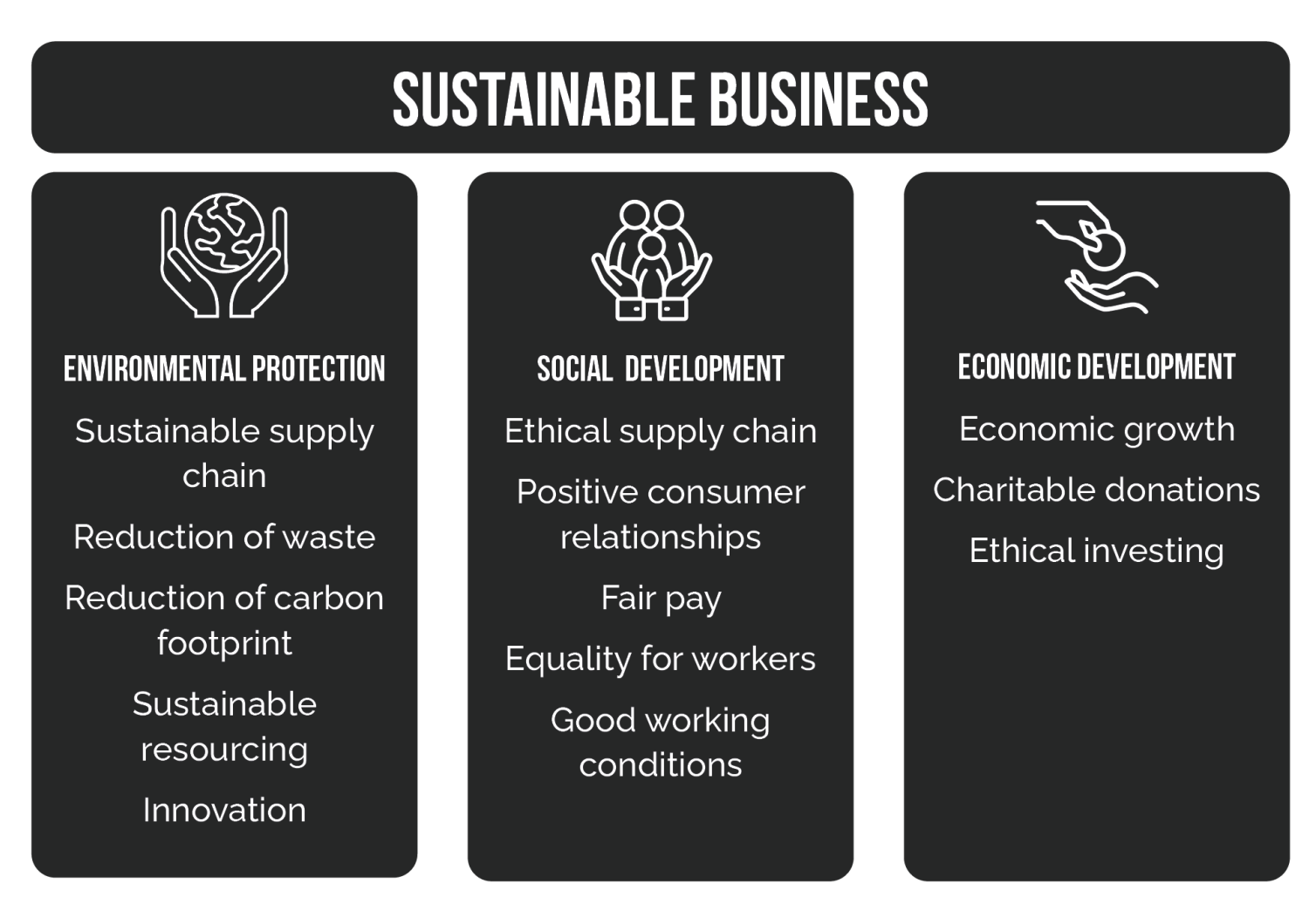
There are several reasons why becoming more sustainable can help a business: increased customer loyalty; employee motivation and efficiency; a growing market opportunity; investor pressure; and brand differentiation just to name a few.
Sustainable business accreditations:
In January 2012,
Patagonia became the first brand to register for benefit corporation status. A
B Corporation is an independently verified company that meets a high standard of social and environmental performance, accountability, and transparency. B Corps aim to create a positive impact on society and the environment; report upon their activity to the public; and uphold corporate social responsibility in their employment, community, and environmental challenges. So far, more than 4,400 companies (c. 640 in the UK) have obtained accredited BCorp status, across 153 industries, and not just small ones either - both Unilever and Coutts Bank are BCorps. Obtaining BCorp status isn't the only way to independently demonstrate a commitment to sustainability - accreditations like
Planet Mark provide certifications that helps to strengthen ESG credentials.
Hang on, can we get back to sustainable marketing?
Yes! But firstly (and I promise I'll make it quick), let’s start with a very quick recap on what marketing is in general.
Marketing sits at the heart of branding, communications, stakeholder relationships, product development and sales. Marketers basically act as mediators between businesses and consumers: they find out who the customer is (research), what the customer wants (more research), what would satisfy that desire (product development), how much they should sell it for (price), who else is selling it (competitor research), how they should promote it (comms and advertising), and finally, how to keep those customers coming back for more (loyalty).
Marketing is a specialist field, but as you can see from the list above, it has a very wide scope. There's not a business on Earth that can avoid doing marketing at some point, whether it's through a dedicated in-house team or just the boss on his Instagram (not recommended).
There are lots of types and methods of marketing that all come with jargon-y names, but are relatively straightforward once you know how they all relate to one another. Generally these fall into two contrasting categories: inbound vs outbound and digital vs traditional. There is a fair amount of overlap, because the majority of outbound marketing employs traditional techniques, while the majority of inbound marketing employs digital methods.
Outbound marketing is all Mad Men, hard sell, disruptive and in your face. It's cold-calling, advertising on billboards and competing to get as much attention as possible. Inbound marketing is like an introvert's answer to that hyper-agressive world: it's relatively modern (the term was coined c. 2006), and has the core aim of 'attracting, engaging and delighting'. It's about creating content that entices customers in their own time, focusing on building long-term relationships between a brand and their customer, rather than pushing a particular product.
The graphic below helps to explain a little bit more:
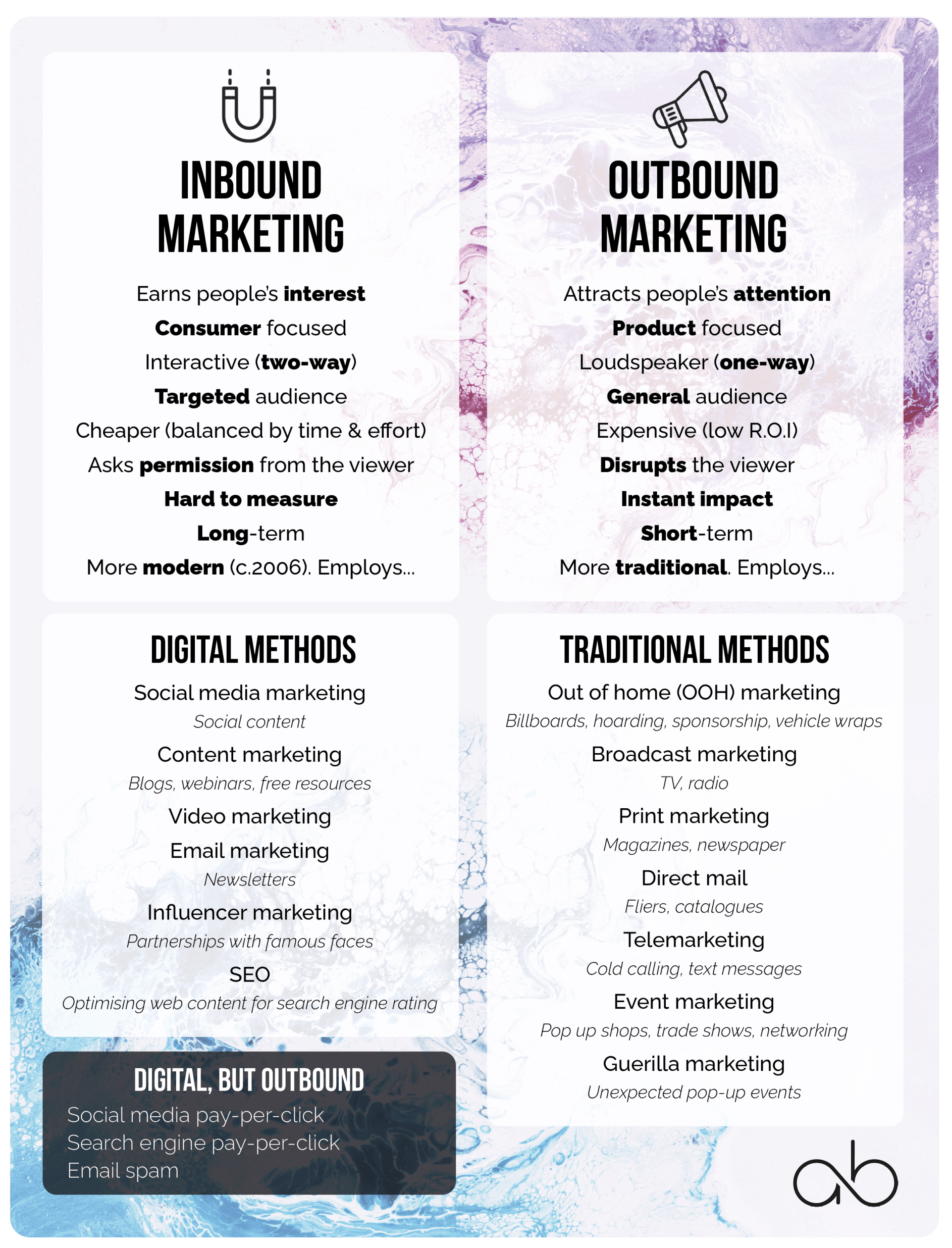
A word on the term sustainable marketing...
Ecological marketing, green marketing, ethical marketing, sustainability marketing… You may have encountered some or all of these terms, often used interchangeably. As the various concepts have become more popular, they have tended to become more confused, and while academics continue to debate the minutiae of their usages, we need a practical solution. At Avery & Brown, we decided to use the term sustainable marketing as a catch all term, here’s why...
Why is sustainable marketing different?
Just as the business world has started to recognise the importance of its environmental and social impact, so too the marketing sector has begun to adapt. We say 'begun' because sustainable marketing is still a relatively niche practice.
Sustainable marketing is basically marketing that upholds the triple bottom line approach; achieving profit for a company without detrimentally impacting our planet and society. It considers the environment as a key stakeholder in the exchange of goods or services.
A recent survey found that only 2% of articles in the 10 most highly ranked marketing journals mentioned sustainability.
[2]
In a normal marketing department, your KPIs would be concerned with return on investment: how has the marketing budget increased brand awareness, spend conversion, and ultimately, profits? This type of marketing is profit driven, and product centric. It tends to focus on pushing a specific product for a set time, before moving on to the next one.
On the other hand, sustainable marketing has a broader scope. It takes environmental and social impact into consideration alongside profitability, considers how a business's 'mission' can guide its strategy from product ideation to promotion, and calculates how that mission can be communicated to customers to build brand loyalty and reputation. To this extent, sustainable marketing has a long-term outlook, focusing on building lasting relationships between a brand and its customers, rather than just a specific product.
Conventional marketing works by constructing an aspirational or emotional fantasy for its consumers, to which it then offers its own product or service as a solution. Think Disney’s ‘The happiest place on Earth’, or Ikea’s ‘The wonderful, every day.’ This approach starts with a product or service and then creates a desire for it by tapping into a consumers’ emotions. Sustainable marketing uses a mission or vision instead, for example, 'reversing deforestation', or 'vegan and cruelty-free beauty products'. It then provides itself, or its products or services as the answer to that mission.
The graphic below helps to clarify the differences:
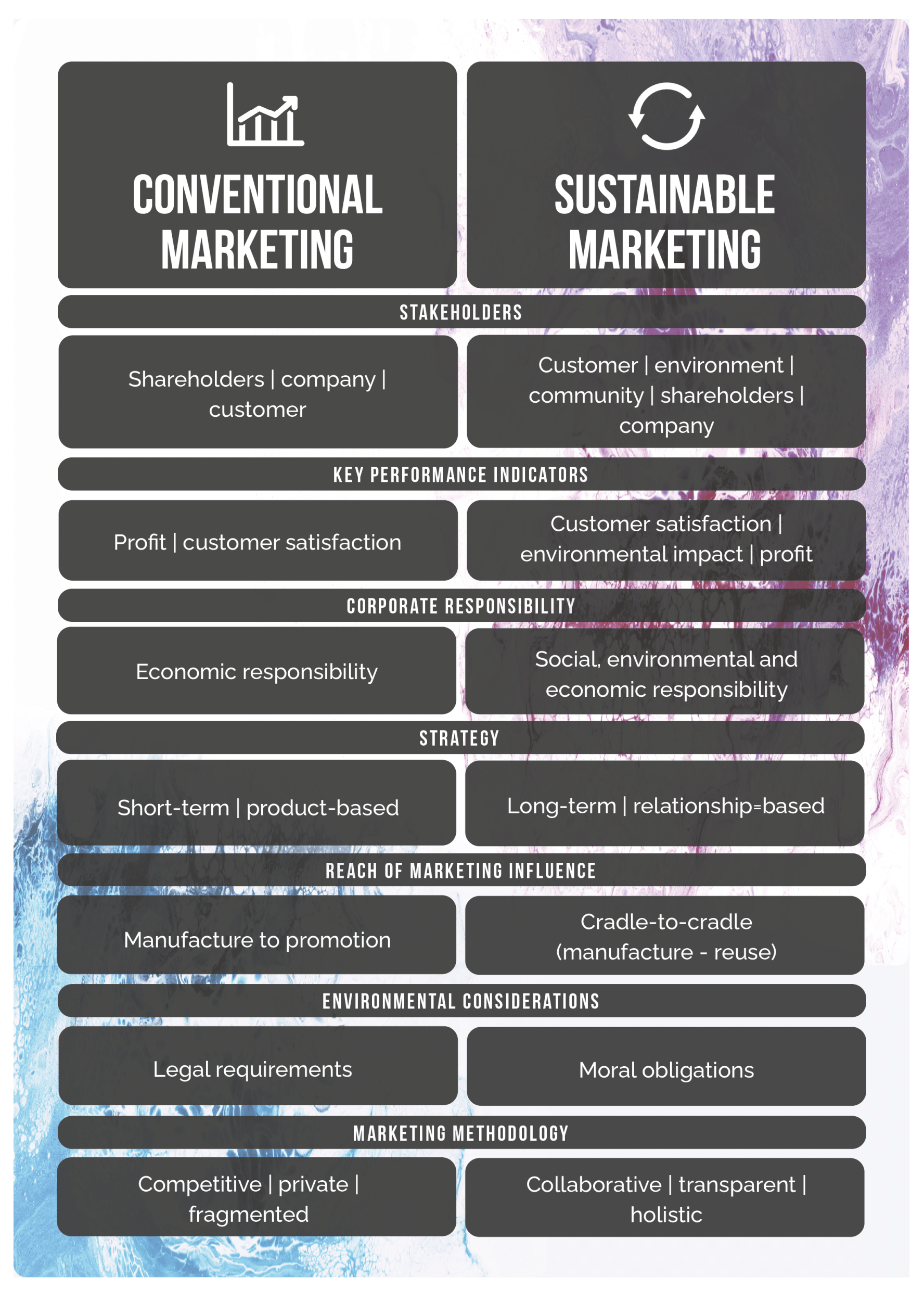
Another thing to note, sustainable marketing is about practising what you preach: it's not just about what you're saying (i.e. the promotion of a brand mission, or a particular sustainable product), but it’s also about how you say it (i.e. the marketing practice itself). Sustainable marketers endeavour to make positive connections with consumers, they aim to employ ethical methods to promote their brands, and to work with partners who share their values. This may mean prioritising transparency (the truth) over optics (looking good), or advertising through an ethical platform, rather than a cheap, easy alternative like Facebook.
Why is sustainable marketing so important?
Awareness about the climate crisis is on the rise, and consumers are becoming increasingly knowledgeable about the influence their buying choices have upon the environment and society. Statistics suggest that the modern consumer wants brands to do more than provide cheap and convenient products or services, they want to buy from brands who demonstrate strong ethics and are aware of their own impact upon the planet. Millennials in particular - who boast $2.45 trillion in spending power - show an inclination towards purpose-driven brands, with over 70% stating they would pay more for a brand that supports a cause they care about. If we take these stats at face value, the case for sustainable marketing and purpose-driven business is clear.
- For business:
the demand is there and it’s increasing, so why not satisfy it? Redefining your mission or establishing yourself as a purpose-driven business makes your brand more attractive to consumers and more visible. Having a clear mission helps you to stand out from your competitors, and the statistics suggest consumers will pay more to have sustainable or ethical products. Regulations are always changing, so sustainable marketing enables you to keep ahead of the curve. Just make sure whatever you claim you're doing is founded in fact.
- For the planet:
we’ve discussed the massive impact that business has upon the planet. We don’t really have much choice if we want to stop climate change and reverse the damage that's already occurred – businesses need to become more sustainable and start prioritising their environmental and social impact.
- For consumers: sustainable marketing is about transparency and authenticity. The current consumer market is rife with greenwashing, confusing statements, and obfuscation – sustainable marketing should make buying decisions more straightforward, so consumers can buy what they want and know it’s not doing harm. Which is reeeally important in tackling the 'attitude-behaviour gap'...
The ‘Attitude-Behaviour’ Gap
You may have heard of this concept, and, unless you're an angel, you're probably guilty of it. Every day, we say or think certain things about ourselves, that are more likely to be aspirational than accurate, particularly when it comes to how we part with our hard-earned money. Marketers have long known there is a gap between what consumers say in surveys, and how they actually behave. While 70% of millennials say they would spend more on a sustainable product, they often just stick to what they know and try not to feel too guilty about it. This isn't necessarily our fault of course! Buying is a minefield of conflicting statements that claim a particular product is better, healthier, smarter, cheaper. In the UK, the Conduct and Markets Authority is supposed to stop companies from downright lying, but it doesn't stop them manipulating the truth. Our lives are complicated enough without having to translate a pile of jargon to make sense of every item we buy. So instead this is usually what happens...
Take Libby as an example. Libby always buy Pantene shampoo and conditioner – it’s mid-range in price, her mum always used it so she has a subconscious sentimental attachment, she knows she can always get it at the supermarket or Boots, so it’s convenient to purchase. She also knows it’s an OK product and doesn’t make her hair too greasy or dry. One day Libby reads a review about shampoo bars and wants to try one out in order to reduce her plastic waste and because she has a vague idea that the long list of chemicals in the Pantene shampoo can't be doing anyone much good.
But when she goes to look, she’s bombarded with 40 different products that claim to do everything from save the planet to make hair grow 6 inches overnight – some claim they are 100% vegan (but then she finds out they it’s been tested on animals), some claim to be 100% natural (but that long Latinate word doesn’t sound like something she’d find in a garden), others are very hard to get hold of (they take 5 days to deliver or have a minimum spend), and all this before she’s even tried the product out.
In the end a friend recommends a TREsemmé product and Libby finds it in Sainsbury’s so buys that instead.
Sound familiar? You can see why it is so important to make sustainable marketing communications as straightforward and truthful as possible. It’s also why a consistent and clear brand persona is key to standing out, and why a genuine mission statement can help to attract customers to you. Arguably, it’s not the money that stops people purchasing sustainable products, it’s the saturation of the market by false claims and fake news. That’s why sustainable marketing that isn’t founded on authentic sustainability credentials from cradle-to-cradle is basically just more greenwash. But it's not just about keeping your consumers happy, as of 2022, it's the law (see The Green Claims Code below).
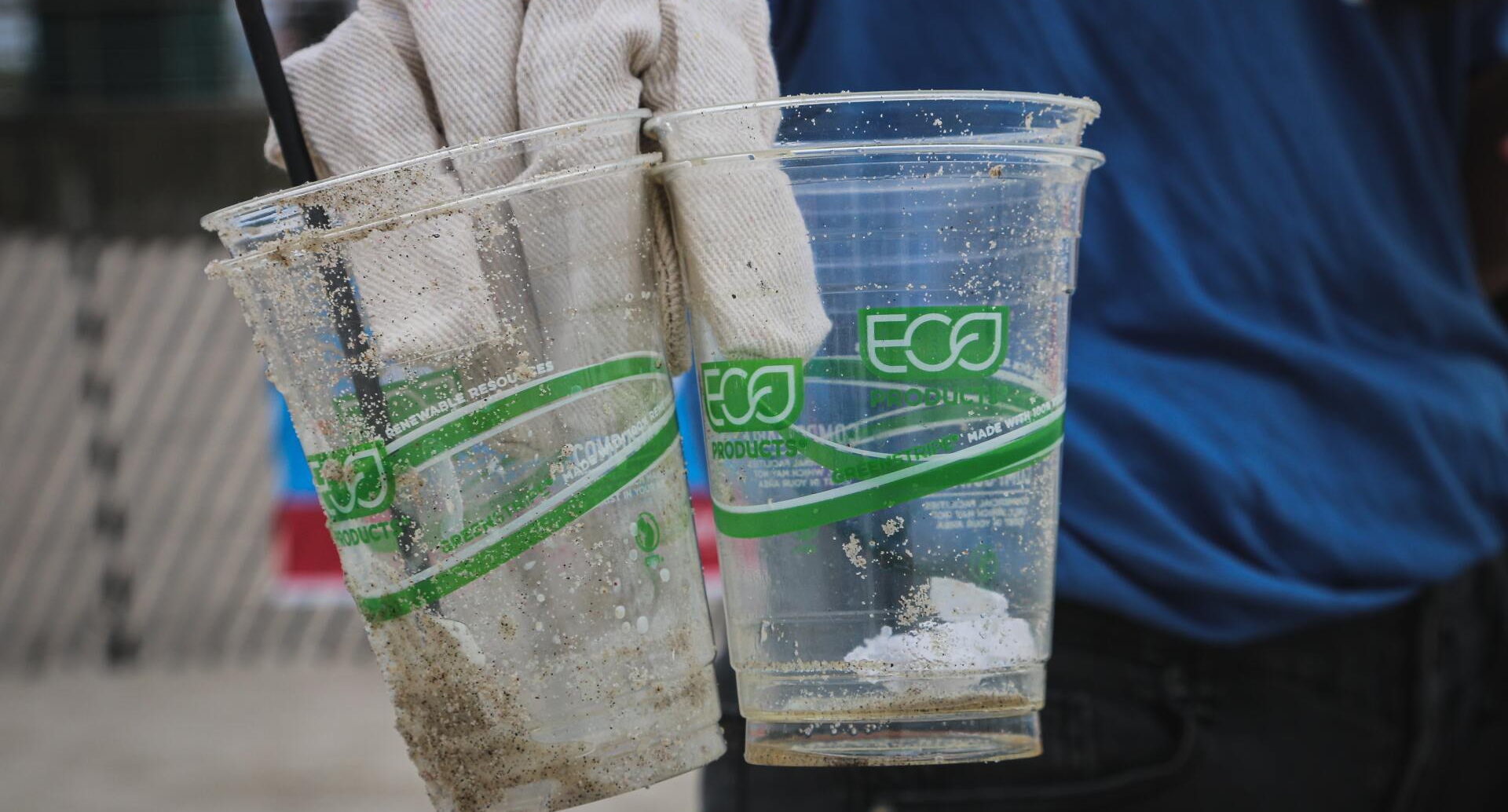
But can marketing really be sustainable?
It’s a big question and a fair one. Historically, the marketing and advertising industries have been the source of much criticism when it comes to sustainability. And rightly so! They are responsible for persuading us to buy stuff we don’t need - or even really want - and to buy things that are not just bad for the environment, but bad for our own health. Whether it's persuading us that Camel cigarettes will make us cooler, that eating lard will make us happier, or that by buying this new version of an iPhone, everything will be OK again. Over the decades, this has led to a huge amount of scepticism about the true agenda of marketers.
What all this has led to is the overconsumption we see today, with consumers buying far more than they could ever need. Overconsumption is a key contributor to environmental damage and climate change – whether it's single use plastics clogging up the oceans, water-intensive cotton used in fast fashion leading to droughts, or non-recyclable complex electronic devices ending up in landfill. But substituting products with more eco-friendly ones is not enough, marketers need to get to the root of the problem - that we all buy more than we need and that resources are finite.

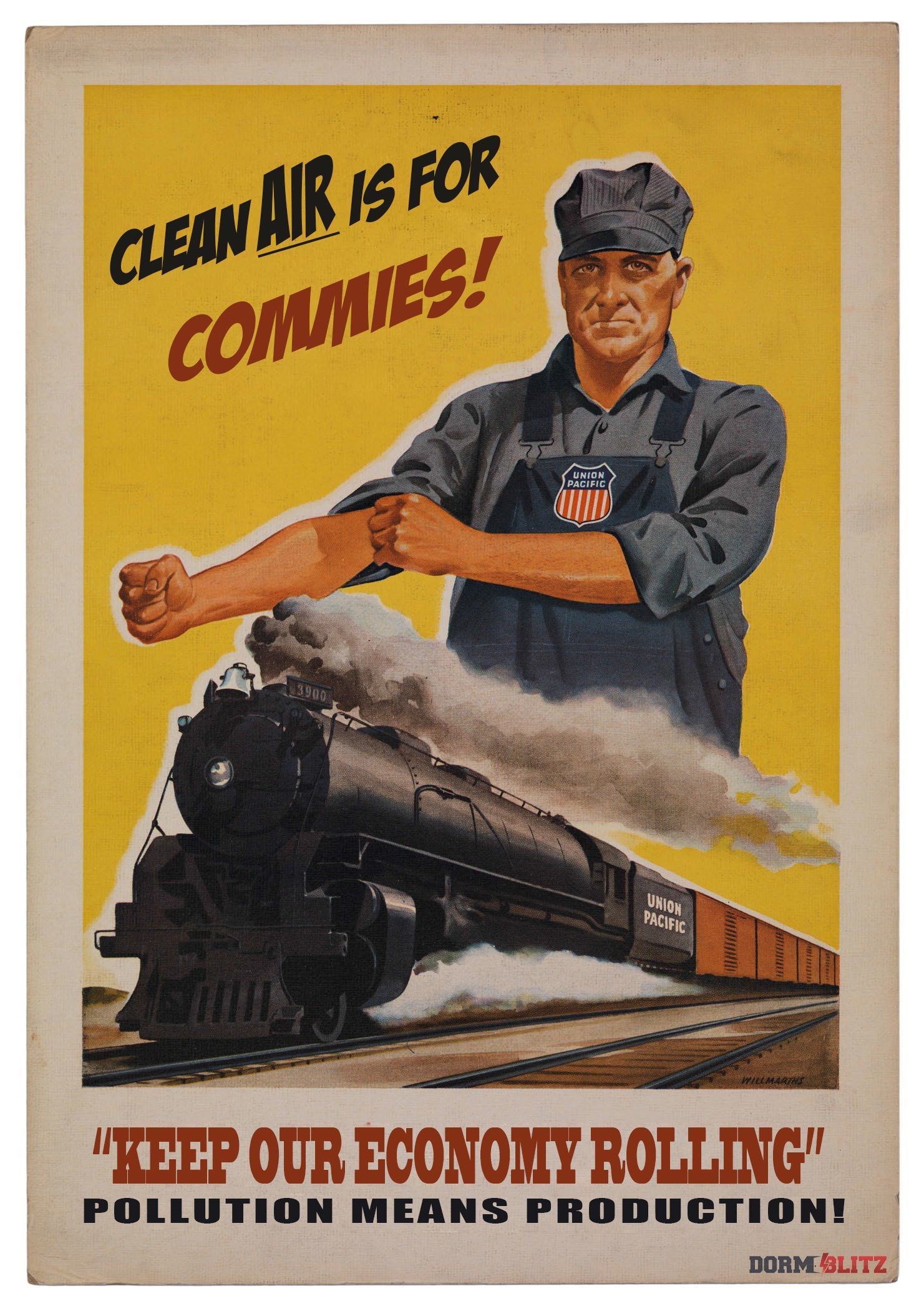

Questionable advertising from the 20th Century - from pregnant smokers to steam-train economies
So how on Earth can marketers help to solve the problem they are partially responsible for creating? Simply put, marketers need to channel their authority in a more responsible direction.
Marketers are essentially mediators between consumers and brands - any good marketer should know what people want (or be able to find out) and understand how to guide a business towards fulfilling that demand. They therefore have a huge influence on both businesses and consumers: an influence that can be used to shape new behaviours, create new ways of working/thinking, educate and inspire hope in consumers and manufactures, and to deliver what's best for people and planet. Not only can marketers promote sustainable consumption and the circular economy, but they can encourage businesses to make their products and processes more sustainable to appeal to the increasing number of conscious consumers.

There’s no one better placed to effect change, align with and influence customers and drive hope for a better, more sustainable future, than an ‘educated and aware’ responsible marketer.
The Sustainable Marketing Manifesto
What is greenwashing?
We’ve mentioned it a few times and you’ve probably heard it a lot in the media in recent years. Greenwashing covers a wide range of activities: from making unsubstantiated or false claims about a particular product or service's environmental credentials, to adopting outwardly green acts as a business, without actually revising or improving internal practises. The primary goal of greenwashing is to improve the public image of a company and maintain profitability, by capitalising on the growing number of green consumers. Sustainability becomes a marketing gimmick that can be launched or stopped whenever is convenient, rather than a thorough process of continuous improvement.
The term was first used by Jay Westerveld, an environmentalist who objected to a hotel’s practice of putting signs in hotel rooms that asked guests to reuse their towels to ‘save the environment’. Westerveld argued that there was little evidence that the hotel had a genuine interest in environmental conservation and was more concerned about saving money on washing. Since then, greenwashing has become central to debates around sustainable business practice, with several companies accused of massive hypocrisy after greenwashing campaigns.
Why is sustainable marketing so hard?
Firstly, because it requires end-to-end behavioural and structural change. Genuine sustainable marketing can only be done from the inside out and can therefore take a long time and require a fair amount of investment, particularly for larger corporations. Luckily, the process itself is a key component of what sustainable marketing actually is. You don’t need to wait for perfection, you just need to start communicating your journey and tracking your improvement, which means you can start small! Whether it’s publishing the results of an emissions report, or a comprehensive ESG brochure, these are examples of the kind of transparency that reassure consumers you’re taking sustainability seriously and are great materials for sustainable marketing campaigns.
Secondly, that word 'investment'. When a company says to a marketer 'what can you do for me?' what they often mean is 'how much profit can you make me?' So it can feel like an uphill struggle trying to battle ignorance or scepticism about the need for sustainable business practice. As a sustainable marketer, there are two possible approaches:
- Educate: sustainable marketing is a collaborative process, so bring as many people along for the ride as you can by talking, cajoling, persuading, lobbying... whatever you want to call it.
- Niche down: create a clear brand persona that says upfront you only want to work with sustainably-minded businesses. That way, you can avoid endless ideological battles from the get go, and only work with people who are already on board. Trust us on this one, the market share is big enough.
Thirdly, when companies don't tell the whole truth, people will find out. Consumers are savvy, the internet is a powerful detective tool, the media has its beady eye on you. Avoid spin and you'll be fine. Reputational damage is a common issue when a company casually adopts sustainable marketing - remember VW's 'Clean Diesel'? Yeah, most of us don't have millions to spare on settlement fees so make sure everything you say is founded on fact. You don't want to be another Shell, HSBC, BP, H&M... oh the list goes on.
The Green Claims Code
In early 2022, the UK Government's Conduct and Markets Authority introduced the Green Claims Code to crack down on unsubstantiated or misleading claims about a product or service's environmental credentials. Companies like Oatly and Innocent have already fallen foul of the new law. Both companies have had their adverts banned for suggesting that by purchasing their products, consumers can help the planet.
Authors of Sustainable Marketing: How to drive purpose with profits, Michelle Carvill and Gemma Butler recommend that companies ask themselves the following questions before communicating any environmental claims:
- Are your claims truthful and accurate?
- Are your claims clear and unambiguous?
- Do your claims omit or hide important information?
- Do they only make fair and meaningful comparisons?
- Have you substantiated your claims?
- Do they consider the whole lifecycle of a product?
Finally, one of the major pitfalls sustainable marketers fall into is
forgetting to answer the age-old question ‘what’s in it for me?’ Sustainable products and services may be better for the planet and for society at large, but how do they benefit the individual buyer? Traditionally, marketing theory has defined three types of value that a consumer looks for:
- Functional benefit: value for money, performance, ease of use or safety.
- Emotional benefit: how will the product make me feel – more intelligent, sexier, happier, more myself?
- Social benefit: how does the product enable me to make a statement to the world about my social status or identity.
The emotional and social benefit categories can be broken down further into two diametrically opposed approaches:
- "You’re amazing. Buy this thing because you deserve it, treat yourself, go on."
"Because you're worth it" L'Oréal | "The best a man can get" Gillette - "You’re not good enough. Buy this thing because you need to be better, healthier, prettier, smarter."
"Make more of what's yours" JP Morgan | "Open happiness" Coca Cola | "Believe in dreams" Tiffany
As we mentioned before, sustainable marketing replaces this unethical carrot-and-stick approach, with a larger environmental or societal mission as the incentive. It focuses upon positive, collective action that empowers the consumer, however, it cannot afford to overlook the need for individualised emotional, functional, and social value propositions. So, remember: what's in it for the business, what's in it for the planet and what's in it for the consumer?

Key principles and tips of sustainable marketing
Here's a round up of our top tips for sustainable marketing to get you started...
Start at the very beginning: every purpose-driven business needs a set of brand statements that guide every aspect of their business strategy, brand persona, and marketing strategy. Sustainability and ethics should be at the core of these statements and guide all resultant decisions and steps. To ensure consistency, marketers should have a seat at the table at every stage of the business from product development, through to strategy, branding, supply chain choices, and partnerships. If you're interested in finding out more about brand strategy and don't know where to start, then get in touch to find out more about our brand strategy workshops.
Think about the big picture: sustainable marketing has a broad focus. Let your consumers know what societal or environmental cause you’re serving, whether it’s 'a world without plastic' or 'no period poverty'. And let that mission drive your decisions. But try and avoid marketing messages that put your company front and centre and distract from the cause. Instead use your platform to create valuable content that highlights related issues or breakthroughs - champion the work of innovators, charities, and influential people who share your mission. For example, if your mission is to eradicate deforestation, don't just talk about how your recycled packaging can help, or how you donated x amount to Ecologi. Instead, create blogs that discuss legal battles in the Amazon, celebrate other companies doing good work, and make social posts exploring the scientific impact of trees upon our ecosystem.
Educate yourself: sustainable marketers bear significant responsibility for learning about climate change and sustainability. In order to communicate truthfully and with simplicity, marketers have to know their stuff – whether it’s about life-cycle assessments, the difference between compostable and biodegradable, or the definition of carbon sequestration or reforestation. It's about making sure that every claim you make is founded in truth. And don't forget to track that journey - if you learn something new write about it in a blog, post about it on your socials or tell your colleagues! Which leads us on to the next thing...
Tell the truth: we can’t stress this enough, transparency is key. Consumers want the truth from brands, not a polished version of it, so build your messaging on facts and proof. None of us are perfect when it comes to our impact upon the planet, and no one expects you to be. Better to advertise the bits you’re great at, talk about the things you’re working on, and acknowledge where there’s room for improvement. Whatever you do, don’t lie, or obfuscate. As Sarah Shilling explains: “Sustainability is unforgiving. More so than price, delivery, and quality. If you get your sustainability messages wrong or your promises are lies, then it’s a long road to try and claw that back.” Which means...
You don't need to wait for perfection: part of being a champion of sustainability is about inspiring others to join in and about going on a journey with them. Perfection is off-putting: customers will want to see the journey and be part of it, watching you move forward helps with accountability and solid customer relationships. You want to inspire others, so communicate with humility and show your mistakes and pitfalls.
Bottom line - follow the law: read up on the Green Claims Code and make sure you stay on the right side of the law by asking yourself the following questions:
- Are your claims truthful and accurate?
- Are your claims clear and unambiguous?
- Do your claims omit or hide important information?
- Do they only make fair and meaningful comparisons?
- Have you substantiated your claims?
- Do they consider the whole lifecycle of a product?
Focus on where you can make the biggest difference: get your company's emissions measured and look at what is causing the biggest emissions, then tackle those and talk about it! Focusing on sustainable packaging that only accounts for 5% of your total footprint, as opposed to the air miles clocked up by the product itself, is leaning towards greenwashing.
Avoid sustainable marketing myopia...
no, not the eye disorder, although that's where the phrase comes from.
Sustainable marketing myopia is when you focus too much on the socio-environmental attributes of a sustainable product or service at the expense of customer benefit and value. It's rooted in traditional theories of marketing myopia, when a company overestimates the importance of company potential and product attributes at the expense of market need. Which leads us to...
...and remember your consumer: as we discussed before, sustainable marketing often focuses on the big picture at the expense of individual value proposition. So make sure to retain some traditional marketing techniques and remind customers what’s in it for them!
Practise what you preach: make sure that your marketing practices are ethical and sustainable too! Remember the diagram comparing inbound and outbound marketing techniques? Well sustainable marketing tends to work best with inbound marketing, because it creates a relationship based on mutual interest and value. It doesn't disrupt the consumer while they're watching Hollyoaks, or trying to read on the Tube, instead it uses strategic content creation to entice them in. It also doesn't eat up your budget - it's a lot less expensive than running paid ads or email marketing spam, but it does require a long-term outlook (see below). This might seem obvious, but it also means rethinking that branded merchandise, avoiding print-intensive brochures and leaflets, and considering how you can make your online presence more environmentally friendly (think green hosting), because our digital carbon footprints shouldn't be overlooked.
Create value for your customer: in order to maintain long-term relationships, you need to see the world through your customers eyes. Creating value for your customers through content marketing like blogs, free resources, recipes, 'how-to' videos or funny TikToks will keep them returning again and again and build an invaluable interactive relationship. Find out what they want to see and go with it - either through your own research or by asking them. Use the channels they use - remember "attract, engage, delight". This kind of marketing should be fun and human, not coldly driven by ROI and data. Inbound marketing takes a lot of time and effort, but so does any good relationship. Keep it up and you'll have brand champions who do half your marketing for you!
Still not sure where to start?
Then let us help you out! We’re experts in sustainable marketing. We help ambitious, sustainability-focused businesses to overcome their marketing challenges and exceed their aspirations for growth. We take a human approach, tailoring our services to meet your needs and budget. So whether you need a full rebrand and marketing strategy, or advice on putting together an ESG brochure, get in touch.
References
[1] Dave Wann, 'Finding Real Wealth: Twice the Value Half the Resources', Less is More: Embracing Simplicity for a Healthy Planet, ed. by Cecil Andrews and Wanda Urbanska (New Society Publishers, 2009)
[2] Purani, K, Sahadev, S, and Kumar, DS (2014), 'Globalisation and academic research: The case of sustainability marketing', IIM Kozhikode Society & Management Review, 3 (1), 93–99
Other resources
- Belz, Frank-Martin and Ken Peattie, Sustainability Marketing (Wiley, 2009)
- Bowden, Tom and Tom Jepson, Shoot the HiPPO: How to be a Killer Digital Marketing Manager (Footprint Digital, 2020)
- Carvill, Michelle, Gemma Butler and Geraint Evans, Sustainable Marketing: How to Drive Profits with Purpose (Bloomsbury, 2021)
- Conway-Wood, Sian, Buy Better Consume Less (Icon Books, 2022)
- Kemper, Joya and Paul Ballentine, 'What do we mean by sustainability marketing?', Journal of Marketing Management, March 2019, 35 (3-4), 277-309
- The Sustainable Marketing Manifesto
Share the love

